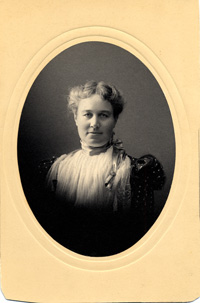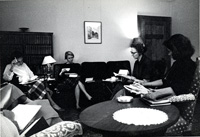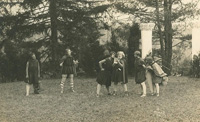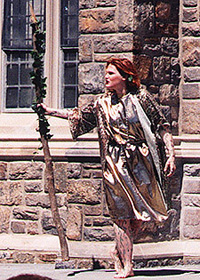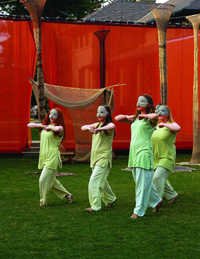The History of Greek and Roman Studies at Vassar College
by Rachel Kitzinger, Professor of Classics and Dean of Planning and Academic Affairs
January 2011
Department Website
The Department's Curriculum
Vassar was the first women's college in the United States with a liberal arts curriculum that included ancient Greek. At the time of Vassar's founding, knowledge of the Classical languages, Latin and Ancient Greek, was a prerequisite for university studies for men and a central part of those studies. The admissions criteria and curricula of Harvard and Yale, after which Vassar modeled its own curriculum, required substantial study in both languages. Vassar modified its admissions requirements to acknowledge that young women may not have had an opportunity to learn Greek; but it incorporated Greek into its curriculum in the belief that what was good for Harvard and Yale students was good for Vassar women. Young women seeking admission to Vassar in its early years were required to pass entrance exams in Latin and a second language, which could be Greek. Sample admissions exams for Greek and Latin are included in the catalogue for 1880-1881. The Latin exam included selections from Caesar, Cicero, and Vergil for translation as well as the requirement that students compose an essay in Latin!
After they arrived in Poughkeepsie, the earliest Vassar students continued their study of Classical languages as part of the "core curriculum" of the college. Beginning in the college's third year, all students chose between a "scientific course" and a "Classical course" of study—students electing the scientific course were required to study Latin for at least a year; those electing the Classical course studied both Latin and Greek throughout their time at the college.
In 1890, Abby Leach and Grace Macurdy (who were often on opposing sides of any question; see below) led the campaign to establish separate but related departments of Greek and Latin, replacing the Department of Ancient Languages. The two departments offered two distinct courses of study, one in Latin and one in Greek. (One wonders if the enmity between the two women, rather than a strong curricular rationale, was the motivating factor for this change!) Courses in Greek and Latin were primarily philological, with individual classes focused on reading important ancient authors in the original language. (There was no opportunity for students to learn the languages from scratch, as it were, until elementary Greek was added in 1915 and elementary Latin in 1944!).
From1890-1920 the new departments expanded their curriculum from philology to a broader vision of "Classical studies" including the study of history, theater, and particularly material culture. Coins, topography, and Greek vases were all added to the advanced curriculum, and a special certificate in Greek archaeology was added to the two majors in Greek and Latin. The catalogue of 1904-1905 proudly proclaims that the "Department is equipped with an electric lantern and has illustrated lectures associated with its courses."
The years surrounding the depression and WWII saw continuing experimentation in the Greek and Latin curriculum. In 1930 a joint major in "Classics" (combining the Greek and Latin majors, which also were retained as separate majors) was introduced. It required study of both ancient languages in a single major, reflecting the beginnings of a unified field of Classics encompassing both the ancient Greek and Roman worlds. In 1936 the Classics major was dropped, presumably because the challenge of mastering both Greek and Latin was too great, and a new major in Classical Archaeology was added, which joined philological study of both languages with archaeological practice. In 1947 the two departments combined into a single department of Classical Languages and Literatures, with students focusing in either Greek or Latin. It was also in the mid-40's that the Department began to offer courses with readings translated into English for non-majors. This model of a single department where students focused either in Greek or in Latin, with curricular offerings in archaeology, history, and literature in translation for majors and non-majors, remained the departmental structure until 2000.
But as early as 1943, the Greek department was also involved in interdepartmental "special" majors. The description in the catalogue of 1943 of one of these majors, "Social and Economic Problems of Greek Civilization," provides remarkable evidence of a consistent desire among faculty to tie the study of antiquity not only to concerns of the present but also to other disciplines' methodologies. The stated objective of this major was "to enlarge and deepen the understanding of the economic, sociological, and anthropological processes of today by studying them in the more objective, relatively limited, but comparably complex civilizations of Greece; to develop a better understanding of ancient civilization by application of modern methods of economics, sociology, and anthropology." The major was jointly administered by the departments of Greek, Economics, Sociology, and Anthropology.
In 2000 the department added a third major in Ancient Societies, which required a year-and-a-half of one of the ancient languages and further study in archaeology, history, philosophy, art, religion and literature, offering multidisciplinary study that students could pursue without extensive knowledge of the languages. In 2010 the department changed its name to Greek and Roman Studies and created a curriculum which emphasized the intellectual community of all the students majoring in the department, whether their approach was philological, archaeological, historical, or literary and whether they focused on Greek or Roman culture.
Throughout the years these changes illustrate the challenge of trying to encompass the study of the ancient Greek and Roman worlds in a coherent and manageable form for undergraduates. The challenge of learning an ancient language, as high schools offered less and less preparation, made the philological aspects of the major difficult for many students; at the same time, the enormous attraction of the richness of cultural, literary, archaeological, and historical material from the ancient world drew increasingly large numbers of students to the department, and the interests of the faculty expanded more extensively into multidisciplinary interests, including the study of other ancient cultures as well as the study of the reception of ancient ideas and works of art by later cultures.
The Faculty
These changes in the curriculum over time were inspired by a remarkable group of classicists who have taught at Vassar over the years. There was a Professor of Latin as well as other instructors in Greek and Latin on the faculty from the college's opening year, although it was not until Abigail (Abby) Leach arrived as the first female professor of Latin in 1885 that the Latin professorship was held for more than a year by the same person. The early years of the department(s) are especially important for the history of classical scholarship because women's colleges—Vassar, Smith, Bryn Mawr and Wellesley in particular--served as the major source of employment for talented women scholars of antiquity who had international reputations and who served on the administrative boards of the American Philological Association, the American Academy in Rome and the American School of Classical Studies in Athens.
Abigail Leach was the first woman to be accepted by Harvard professors as a student, although there was no Radcliffe at the time and certainly no female Harvard students. Because of her success studying Greek and Latin with Harvard professors, the "Annex" was founded, later to become Radcliffe. She taught at Vassar from 1885-1914 and served as the first female president of the American Philological Association in 1900, one of four early female Vassar faculty members to do so.
Grace McCurdy joined the faculty in 1893 and taught until 1937. She received a PhD from Columbia in 1903 and was the first woman classicist to study the lives of ancient women. President McCracken described her at her retirement in 1937: "Her deep interest in the achievements of women and in their opportunities both for political and for social equality has led her studies of late into the history of Greek women. Her humor, her gaiety, and her eloquence have combined with her rare learning to bring distinction to the classical studies that have made graduates of Vassar desired in every graduate school."
After several years of peaceful coexistence as the two faculty teaching Greek and Latin, the relationship between Leach and McCurdy soured and in 1906 Leach began a campaign to get McCurdy fired. She tried to alienate her students and manipulate teaching schedules so that McCurdy might be increasingly marginalized. President Henry McCracken writes about an encounter with Leach on the second day of his presidency:
"On the second day of my term there entered my office Miss Abbie [sic] Leach, Professor of Greek, bearing a satchel which she emptied upon my desk. ‘These documents,' she said, ‘constitute the basis of my charges against Miss Macurdy, the other member of my department.' . . . I stood up, gathered the papers solemnly, replaced them in Miss Leach's bag, and placed it by her side. ‘Miss Leach, take back these papers, and never let me see or hear of them again. My administration began yesterday. It will never review what happened yesterday or the day before that.'. . . Not that the matter was ended. When I recommended Grace Macurdy for promotion, as I did at the end of the semester, it was without Miss Leach's approval. In its place, I had a dozen letters from scholars of equal eminence in the faculty. Miss Macurdy won her way to eminence as a scholar, writer, and teacher, and today is remembered as one of the most distinguished professors in Vassar's long list. . . . Let it be said at once that Miss Abbie Leach was also a distinguished woman and teacher of no common quality. . . To her further credit be it recorded, that when she knew of her own mortal illness, she arranged to pay a formal call upon Miss Macurdy in her chambers, and drank the tea of reconciliation with her. It was a heroic act, worthy of Thermopylae." (Henry Noble MacCracken in his book The Hickory Limb, 64-65)
Since this chaotic and bellicose history of its early years, the department has been a model of cooperation and mutual support among faculty and students, with only occasional disruptions, caused by classicists' characteristic tendency to be passionate about their field and method of study.
Elizabeth Hazelton-Haight was the first Vassar Classics major (graduating in1894) to return to the school as a faculty member, in 1902. She earned her M.A. from Vassar in 1899 and her PhD from Cornell in 1909. She taught only Latin in her 44 years at Vassar. She began the Vassar Classical Museum and served as the 2nd female president of the American Philological Association from 1933-34. She wrote eleven books on a variety of classical, subjects, both Greek and Roman (and three books on Matthew Vassar and his "Magnificent Enterprise.") Her last book was published when she was 82.
As Don Lateiner writes about her in an article in The Classical World, "Professor Haight was a campus character at Vassar, a forbidding force in the classroom, the department, and at faculty meetings. She held strong opinions about everything. She told personal anecdotes about her colleagues in class to her students. Yet for forty years she was helpful and gracious to those students and colleagues whom she liked. Having served as chairperson of the Latin department for nearly two decades, she liked to "keep her hand in the department," even after retirement, during much of the next two decades. She died not far from Vassar in a nursing home, November 15, 1964, at the age of ninety-two."
Elizabeth Pierce Blegen
Elizabeth Pierce was a student at Vassar, receiving her MA in Latin in 1912 and her PhD from Columbia in 1922. From 1915-1922 she taught ancient art at Vassar and was assistant curator for the Art Gallery. Of all the distinguished women classicists who were involved early on with the Vassar Department Elizabeth Pierce Blegen has had the most long-lasting effect on the department. Her will bequeathed an endowment to the department to support research in classical antiquity and has allowed the department to bring a research fellow or distinguished professor to the college every year since xxxx to teach a course and do research. Although she only taught in the department for seven years, her life-long association with another Vassar classicist, Ida Thalon Hill, who was a member of the department from 1906-1924, kept her connection to Vassar strong. Both women spent most of their professional lives in Athens, at the American School of Classical Studies; each married archaeologists whom they met there: Carl Blegen and Bert Hodge Hill. The four of them shared a house in Athens and supported, in a variety of ways, each other's work. This connection between Vassar and the American School of Classical Studies has remained strong, as has the importance of archaeology as part of a Classics curriculum.
Lily Ross Taylor, of all the women who taught Latin at Vassar, probably had the most distinguished career. She received her PhD from Bryn Mawr in 1912 and taught at Vassar from 1912 -1927, after which she returned to Bryn Mawr, where she remained for the rest of her career. She was a Latinist and in 1917 was named the first female Fellow of the American Academy at Rome; she served as the 3rd female president of the American Philological Association in 1942. Her interest in Roman cult and Roman politics, about which she wrote seminal works, was continued by her successor at Vassar, Inez Ryberg, who shared not only intellectual interests with Lily Ross Taylor but also a debt to the American Academy in Rome, which nurtured both of their scholarly careers.
Inez Ryberg was educated in the Midwest at the Universities of Minnesota and Wisconsin. She came to Vassar in 1927 and taught there until 1965. She broke the mould of most of her predecessors in the department by not coming from the East Coast and by marrying and remaining married throughout her career at Vassar, although her husband, a chemist, did not live in Poughkeepsie, and they saw each other mostly on weekends throughout her career. Like her predecessor, Lily Ross Taylor, her career took shape at the American Academy in Rome, and she too served as the President of the American Philological Association, in 1962, only the sixth woman to do so. Her work as a scholar of Roman antiquity was strongly multidisciplinary; in various ways she illuminated the cultural and historical intersections of art, archaeological remains, and textual evidence. She had a special interest in Roman Religion. As Christine Havelock, Professor of Greek art in the Vassar Department of Art, wrote of Inez, "(she) enjoyed a well-balanced life in that her private circumstances were in harmony with her public career as a teacher and internationally known scholar. She was unusually industrious, ambitious and efficient in every one of her undertakings."
Departmental Character
One of the prominent characteristics of the department is its long-lived connection to material culture and archaeology, nurtured by the scholarship of many faculty members thought its history. Vassar students have had unusual opportunities to understand the connections between material culture and literary and historical texts and have been encouraged to experience the physical remains of antiquity in Greece and Italy, as well as to learn archaeological techniques by participating in digs throughout the Mediterranean world.
The department has also had a tradition of putting on theatrical performances of Greek tragedy. The earliest was a performance (in ancient Greek) of Antigone in 1893. The production, with an all-female cast, cost $4,000—nearly ten times the cost of tuition at the time. In 1931 Hallie Flanagan, the founder of the Drama department, directed a performance of Hippolytos in Greek, in which Philip Davis, a member of the Classics Department, performed. In 1934 Hallie Flanagan and Philip Davis were married, while he was on sabbatical in Greece. More recently, in 1999, this tradition (of performance, not of the marriage between participants in the performance!) was revived when three Greek majors chose to do a joint production of Euripides' Bacchae in the original language as their thesis work. The cast of men and women were all fellow students. In 2007 Professor Rachel Kitzinger directed Oedipus at Colonus, this time in English, using her own and Professor of English Eamon Grennan's translation of the play. As with Flanagan's Hippolytos the production was a joint effort between the Classics and Drama departments. A professor of drama played Oedipus; other parts were taken by Drama or Classics students. The music was composed by a Vassar alumnus; the set designed by a Vassar alumna; and the choreography was created by a Classics and Dance student as her senior thesis.
In recent years the faculty has expanded the multidisciplinary interests displayed by early members of the department into teaching in a number of multidisciplinary programs: Jewish Studies, Media Studies, Women's Studies, and the College Course program. Courses in the department have explored in explicit ways the influence of ancient cultures on contemporary culture and the ways modern points of view provide an interesting lens through which to view antiquity.

